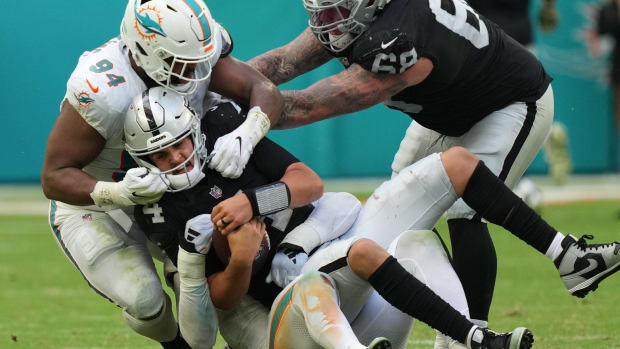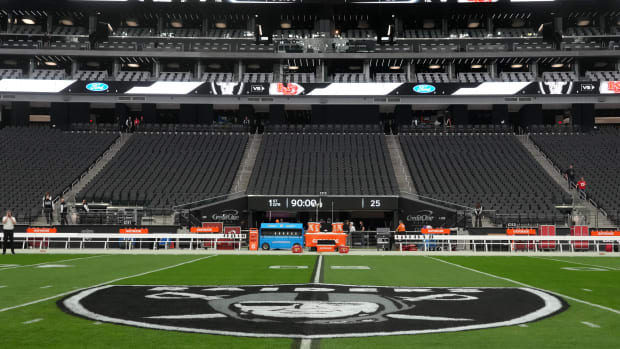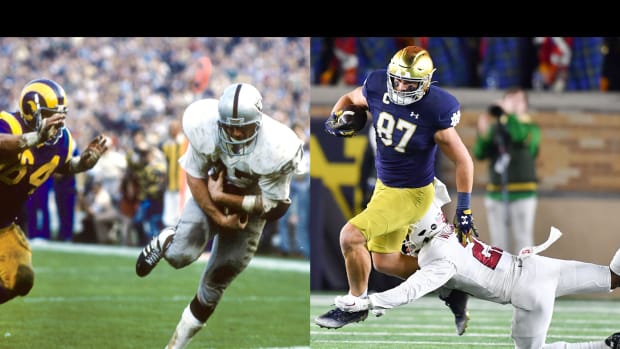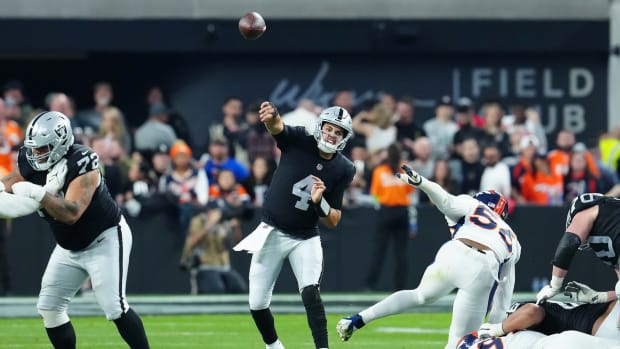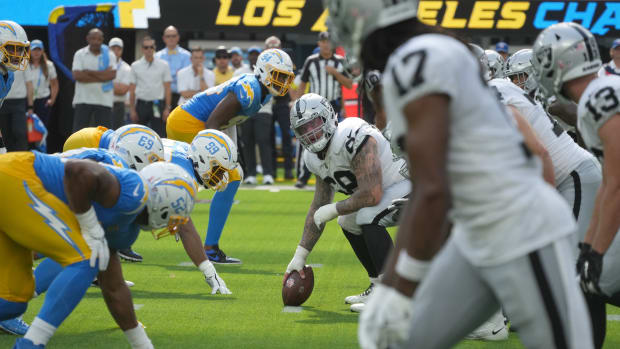Raiders All-Time Top Five: Guards
1. Gene Upshaw, 1967-1981
When the Raiders drafted Gene Upshaw in the first round (No. 17 overall) of the 1967 AFL Draft out of Texas A&I, a lot of people wanted to know, “Who is Eugene Upshaw?” Uppy showed them right away, taking a starting spot at left guard as a rookie as the Silver and Black made it all the way to Super Bowl II, and becoming probably the best putting guard in NFL history over his brilliant 15-year career. The 6-5, 260-pound Upshaw played between center Jim Otto and tackle Art Shell for several seasons, and all three made it to the Pro Football Hall of Fame, Upshaw being elected in 1987. Upshaw was an outstanding pass blocker but was known even more as a devastating run blocker who earned the nickname of Highway 63 (for his jersey number), as he led the way for such outstanding running backs as Clem Daniels, Charlie Smith, Marv Hubbard, Mark van Eeghen and Pete Banaszak—who are all on the Raiders top 10 list of all-time leading rushers. Upshaw was a six-time Pro Bowl selection, made first-team All-Pro three times and second-team another six times, was a three-time All-American Football League All-Star, was named to the NFL 1970s All-Decade Team, the NFL 75th Anniversary Team, and the NFL 100th Anniversary Team. In addition, he was the only player in NFL history to play in the Super Bowl in three decades until Tom Brady did it this year, starting for the Raiders as they won Super Bowls XI and XV. After retiring, Upshaw became Executive Director of the NFL Players Association, a position he held at the time of his death in 2008 at age 63 because of pancreatic cancer.
2. Steve Wisniewski, 1989-2001
“The Wiz” is one of the greatest Raiders linemen of all time, but incredibly he almost didn’t play for the Silver and Black. The Dallas Cowboys selected the two-time All-American from Penn State in the second round (No. 29 overall) in the 1989 NFL Draft, but inexplicably they traded him to the Raiders for four draft choices on the same day. The 6-4, 305-pound Wisniewski would play the next 13 seasons at an extremely high level, making the Pro Bowl eight times in addition to being selected first-team All-Pro twice, second-team All-Pro in six other years, and being selected to the NFL 1990s All-Decade Team. Those would seem to be Pro Football Hall of Fame credentials, but he might be another Raiders great who is being overlooked by the feeling around the NFL that there are already too many members of the Silver and Black in the HOF. Wisniewski started all 206 games he played for the Raiders in his career, missing only two because of injuries, and was called for only 12 holding penalties in his career. He blocked for running backs Marcus Allen, Bo Jackson, Napolean Kaufman, Tyrone Wheatley, Harvey Williams, Kenny King, Charlie Garner, Frank Hawkins, Arthur Whittington, and Steve Smith—who all rank in the top 25 on the Raiders list all-time leading rushers. Wisniewski served as an assistant offensive line coach for the Raiders in 2011 and has remained close to the team ever since.
3. Mickey Marvin, 1977-87
The 6-4, 270-pound Marvin was drafted by the Raiders in the fourth round (No. 112 overall) of the 1977 NFL Draft out of Tennessee and took over as the starting right guard in his second season, learning the ropes from the Hall of Fame left guard Gene Upshaw. Marvin started 108 of the 120 games he played in his career, and like many other Raiders, lineman played a bit in anonymity with Upshaw and tackle Art Shell, All-Pros, and future Hall of Famers, on the same line. However, Marvin played key roles as the Silver and Black beat the Philadelphia Eagles, 27-10, in Super Bowl XV and routed the Washington Redskins, 38-9, in Super Bowl XVIII—winning as underdogs both times. As the Raiders amassed 378 yards against the Eagles, Marvin outplayed All-Pro nose tackle Charlie Johnson, and as the Silver and Black went for 403 yards against the Redskins, he dominated All-Pro defensive tackle Dave Butz. Marvin died after a long battle with amyotrophic lateral sclerosis (also known as Lou Gehrig’s Disease) in 2017 at the age of 61 in his childhood hometown of Hendersonville, N.C.
4. George Buehler, 1969-1978
The 6-2, 260-pound Buehler played right guard on what many observers believe was the greatest offensive line in NFL history, alongside center Jim Otto, guard Gene Upshaw, tackle Art Shell, and tight end Dave Casper, who all are enshrined in the Pro Football Hall of Fame in Canton, Ohio. The Raiders selected Buehler in the second round (No. 50 overall) of the 1969 AFL-NFL Draft (the year before the merger was complete) out of Stanford. A brilliant man, Buehler somehow thought he was an underachiever because several other members of his family were doctors, lawyers, and successful business executives. However, Raiders quarterback Kenny “Snake” Stabler was glad to have him, saying, “George Buehler has the perfect build for an offensive guard, like a Coke machine with a head on it.” When the Raiders routed the Minnesota Vikings, 32-14, in Super Bowl XI, piling up a then-Super Bowl record 429 yards of total offense, Buehler dominated Vikings defensive tackle, Doug Sutherland, helping Clarence Davis rush for 137 yards, Mark van Eeghen add 73 and Pete Banaszak run for two short-yardage touchdowns. He was a ballhawk for a guard, recovering eight fumbles in his career. At Whittier High in Southern California, Buehler was Southern Section Player of the Year in 1964, and also was a champion heavyweight wrestler and shot-putter before going to Stanford.
5. Wayne Hawkins, 1960-1969
A bit undersized at 6-foot, 240 pounds, Hawkins was a fixture at right guard next to Hall of Fame center Jim Otto for all 10 seasons of the American Football League, from 1960-69. Hawkins, who played with Raiders great quarterback Tom Flores at the University of Pacific in Stockton, Calif., was selected in the second round of the first AFL Draft in 1960 by the Denver Broncos, but somehow wound up on the Oakland roster through the Allocation Draft. Hawkins played in 136 games in his career with the Raiders, missing only six because of injuries until his last two seasons. Despite his size, Hawkins was selected to the All-AFL team five straight years through 1967, when he helped the Raiders reach Super Bowl II against the Green Bay Packers, who won the game, 33-14. In that game, he played against Hall of Fame guard Jerry Kramer of the Packers, who like Hawkins was born and grew up in Jordan, Utah. Their mothers were friends and they shared the same doctor growing up. Hawkins was selected to the All-Time AFL Team and the AFL Hall of Fame. A left knee injury ended Hawkins’ career in 1969, and he spent the 1970 season on the Raiders taxi squad before announcing his retirement, In 2016, he underwent a total knee reconstruction, followed by right hip replacement surgery a year later, which was followed days later by a stroke, and now he suffers from dementia. In the mid-1980s, Hawkins worked with fellow Raiders Bob Svihus and Dave Dalby to write the book, Raider: How Offensive Can You Be? A 25-year History of the Oakland Raiders.
Please make sure you tell us your thoughts when you like our Facebook Page WHEN YOU CLICK RIGHT HERE.
Want the latest breaking Las Vegas Raiders news delivered straight to you? CLICK THE FOLLOW button on the top of the page. Don't miss any of the latest up to the second updates for your Las Vegas Raiders when you follow on Twitter @HondoCarpenter, @HikaruKud1
